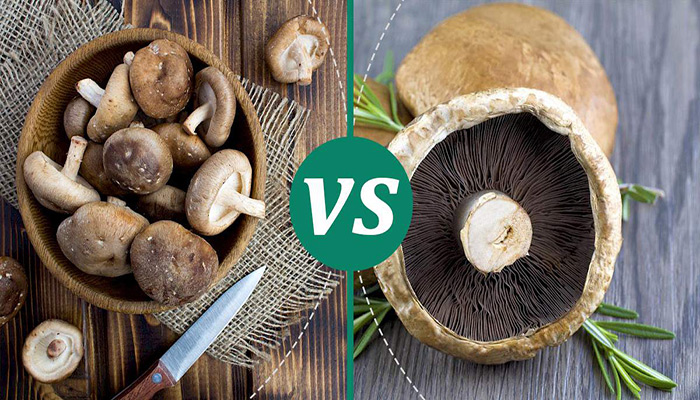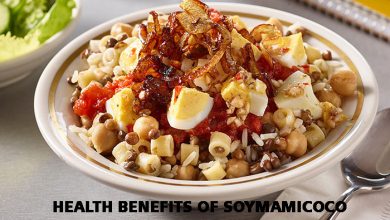Portobello Mushrooms Vs. Shiitake: What’s The Difference?
Difference Between Portobello Mushroom Vs. Shiitake Mushroom

Portobello mushrooms, originating from Europe and North America, boast a substantial, meaty texture that frequently makes them a preferred alternative to steak or hamburger. These mushrooms represent the mature stage of common white or crimini mushrooms. On the other hand, Shiitake mushrooms, rich in iron and characterized by a smoky taste, hail from Asia and feature a round cap with a dark underside. While both Shiitake and Portobello mushrooms find extensive use in culinary endeavors, they diverge in terms of flavor, texture, size, and cost. Read here Portobello Mushroom Vs. Shiitake: What’s The Difference with ecology?
In the realm of health and nutrition, both mushrooms present unique advantages. Shiitakes, with compounds like lentinan and a range of vitamins and minerals, offer potential immune-boosting and cardiovascular benefits. Portobellos, with their protein content and array of vitamins and minerals, make for a nutritious and low-calorie addition to various diets.
What are Portobello Mushrooms?
Portobello mushrooms, scientifically known as Agaricus bisporus, are a mature and fully grown version of the common white or crimini mushrooms. These mushrooms are native to Europe and North America. One of their distinctive features is their large, wide cap, which has a meaty texture and a rich, earthy flavor. The cap can measure several inches in diameter.
Due to their robust texture and flavor, Portobello mushrooms are often used in cooking as a meat substitute, especially for steak or hamburger dishes. They can be grilled, roasted, sautéed, or used in various recipes to add a savory and substantial element. Additionally, their versatility allows them to be a popular choice for vegetarian and vegan dishes.
What are Shiitake Mushrooms?
Shiitake mushrooms, scientifically known as Lentinula edodes, are a type of edible fungus native to East Asia, particularly Japan, China, and Korea. These mushrooms have been cultivated for centuries and are highly valued for their distinct flavor, nutritional benefits, and medicinal properties.
Shiitake mushrooms have a unique appearance with a brown, umbrella-shaped cap that ranges in size from small to large. The cap is usually smooth, and the underside features dark gills. In terms of taste, Shiitakes are known for their rich, savory, and smoky flavor.
Notably, Shiitake mushrooms are recognized for their nutritional content, containing various vitamins, minerals, and antioxidants. They are particularly high in iron, making them a valuable addition to a balanced diet.
In culinary applications, Shiitake mushrooms are used in a variety of dishes, including stir-fries, soups, stews, and sauces. They can be enjoyed both fresh and dried, with the dried form often intensifying their flavor. Additionally, Shiitakes are widely used in traditional medicine for their potential health benefits.
Shiitake Mushrooms vs. Portobello Mushrooms: Ecology
Ecologically, Shiitake and Portobello mushrooms have distinct natural habitats and growth preferences.
-
Shiitake Mushrooms:
- Native Habitat: Shiitake mushrooms are native to East Asia, including Japan, China, and Korea. In the wild, they are often found on decaying hardwood trees, particularly oak, chestnut, and beech.
- Cultivation: Shiitakes are commonly cultivated on artificial logs or sawdust-based substrates, replicating their natural environment. They thrive in humid and cool conditions.
-
Portobello Mushrooms:
- Native Habitat: Portobello mushrooms are the mature form of common white or crimini mushrooms (Agaricus bisporus) and are native to Europe and North America. In the wild, they are often found in grassy areas and woodlands.
- Cultivation: Cultivation of Portobello mushrooms usually involves a composted substrate. They are grown in conditions that mimic their natural habitat, including controlled temperature and humidity.
While both types of mushrooms have been successfully cultivated, their ecological preferences influence the cultivation methods used to ensure optimal growth and yield. Shiitake mushrooms have a more specific association with certain tree species, while Portobello mushrooms are adapted to a broader range of environments.
Read here – Kratom Capsules Benefits
The Cultivation of Shiitake and Portobello Mushrooms
Cultivation of Shiitake Mushrooms:
- Substrate Preparation:
- Shiitake mushrooms are often cultivated on hardwood logs or sawdust-based substrates.
- Logs are typically obtained from deciduous trees like oak, chestnut, or beech. They are inoculated with Shiitake spores or mycelium.
- Inoculation:
- The logs are inoculated with Shiitake spawn, a mycelium culture of the mushroom.
- The spawn is introduced into holes drilled into the logs or mixed into sawdust substrates.
- Incubation:
- Inoculated logs or substrates are kept in a controlled environment with specific temperature and humidity conditions.
- During this incubation period, mycelium colonizes the substrate.
- Fruiting Conditions:
- After colonization, the logs are exposed to specific environmental conditions, often involving a change in temperature and humidity.
- Shiitake mushrooms form and grow on the surface of the logs, ready for harvest.
Read Cultivation of Portobello Mushrooms:
- Substrate Preparation:
- Portobello mushrooms are a mature form of common white or crimini mushrooms (Agaricus bisporus).
- The cultivation process involves a substrate of composted organic materials, such as straw and horse manure.
- Inoculation:
- The substrate is inoculated with mushroom spawn, which is a culture of mycelium from the desired strain of Agaricus bisporus.
- Casing Layer:
- After inoculation, a layer of casing material (often a mix of peat, limestone, and vermiculite) is added on top of the substrate to encourage mushroom formation.
- Incubation and Pinning:
- The inoculated substrate is allowed to incubate in a controlled environment until mycelium colonization is complete.
- Once colonization is achieved, conditions are adjusted to encourage pinning, the initial stage of mushroom formation.
- Fruiting Conditions:
- The environment is further adjusted to promote fruiting, including maintaining specific temperature, humidity, and light conditions.
- Portobello mushrooms mature and are ready for harvest.
Both Shiitake and Portobello mushroom cultivation involve careful control of environmental factors and stages to ensure successful growth. While Shiitakes are often associated with log cultivation, Portobellos are commonly grown on composted substrates.
Read More – Fraudulent CBD Products
Best Culinary Uses
Culinary Uses of Shiitake Mushrooms:
- Stir-Fries and Asian Dishes:
- Shiitake mushrooms are frequently used in Asian cuisine, adding a savory and umami-rich flavor to stir-fries, noodle dishes, and rice-based meals.
- Soups and Broths:
- Dried or fresh Shiitake mushrooms are popular additions to soups and broths, enhancing the depth of flavor with their smoky and earthy notes.
- Vegetarian and Vegan Dishes:
- Due to their meaty texture and robust flavor, Shiitake mushrooms are often used as a meat substitute in vegetarian and vegan recipes, including burgers, sandwiches, and wraps.
- Grilled or Roasted:
- Whole Shiitake mushrooms or slices can be grilled or roasted, offering a delightful smokiness. They can be enjoyed as a side dish or added to salads.
- Stuffed Mushrooms:
- Shiitakes make excellent candidates for stuffing. They can be filled with a variety of ingredients, such as cheese, herbs, and breadcrumbs, creating a flavorful appetizer.
Culinary Uses of Portobello Mushrooms:
- Grilled or Roasted “Portobello Steaks”:
- Portobello mushrooms, with their large size and meaty texture, are often grilled or roasted and served as a substantial main course, sometimes referred to as “Portobello steaks.”
- Burgers and Sandwiches:
- Portobello mushrooms can be used as a vegetarian or vegan burger patty, providing a satisfying alternative to meat in burgers and sandwiches.
- Stuffed and Baked:
- The large cap of Portobello mushrooms is ideal for stuffing with various ingredients like cheese, herbs, breadcrumbs, and other vegetables before baking.
- Sautéed or Pan-Fried:
- Sautéed Portobello mushrooms can be used as a versatile ingredient in a wide range of dishes, from pasta to risotto, adding a hearty and savory element.
- Pizza Toppings:
- Sliced Portobello mushrooms make excellent toppings for pizzas, contributing a rich and earthy flavor to the overall taste profile.
Both Shiitake and Portobello mushrooms bring unique flavors and textures to a variety of dishes, and their versatility makes them popular choices in a range of culinary creations.
Comparison chart
| Feature | Shiitake Mushrooms | Portobello Mushrooms |
|---|---|---|
| Scientific Name | Lentinula edodes | Agaricus bisporus (mature form) |
| Native Habitat | East Asia, including Japan, China, Korea | Europe and North America |
| Cultivation Substrate | Hardwood logs, sawdust-based substrates | Composted organic materials (e.g., straw, horse manure) |
| Flavor Profile | Rich, savory, smoky | Meaty, earthy, substantial |
| Texture | Firm and meaty | Meaty and substantial |
| Cap Appearance | Brown, umbrella-shaped | Large with a wide cap |
| Common Culinary Uses | Stir-fries, soups, Asian dishes | Grilled “steaks,” burgers, stuffed mushrooms |
| Vegetarian/Vegan Options | Frequently used as a meat substitute | Commonly used as a meat substitute |
| Popular Cooking Methods | Stir-frying, grilling, roasting | Grilling, roasting, sautéing, stuffing |
| Nutritional Highlights | High in iron and various nutrients | Rich in vitamins, minerals, and antioxidants |
| Popular Cultural Use | Common in Asian cuisine | Widely used in Western and Mediterranean cuisines |
This comparison chart provides an overview of the key features, characteristics, and culinary uses of Shiitake and Portobello mushrooms. While both mushrooms share versatility and are used as meat substitutes, they have distinct flavors, textures, and cultural associations.
Read More – Sushi Vs Sashimi vs Nigiri
Nutrition and Health Benefits
Shiitake Mushrooms:
- Nutritional Profile:
- Vitamins: Shiitake mushrooms are a good source of B-vitamins, including B2 (riboflavin), B5 (pantothenic acid), and B6 (pyridoxine).
- Minerals: They contain various minerals, such as copper, selenium, manganese, and zinc.
- Dietary Fiber: Shiitakes provide dietary fiber, promoting digestive health.
- Bioactive Compounds:
- Lentinan: A polysaccharide found in Shiitake mushrooms, lentinan is believed to have immune-boosting properties.
- Antioxidant Properties:
- Shiitakes contain antioxidants like ergothioneine and selenium, which help combat oxidative stress.
- Potential Health Benefits:
- Immune Support: Some studies suggest that compounds in Shiitake mushrooms may enhance immune function.
- Cardiovascular Health: Components like eritadenine may contribute to maintaining healthy cholesterol levels.
Portobello Mushrooms:
- Nutritional Profile:
- Protein: Portobellos are relatively high in protein, making them a valuable option for vegetarians.
- Vitamins: They provide B-vitamins, including B2 (riboflavin), B3 (niacin), and B5 (pantothenic acid).
- Minerals: Portobello mushrooms contain minerals such as potassium, phosphorus, and selenium.
- Dietary Fiber:
- Portobellos are a good source of dietary fiber, promoting digestive health and providing a feeling of fullness.
- Antioxidant Properties:
- Like other mushrooms, Portobellos contain antioxidants that help neutralize free radicals in the body.
- Low in Calories:
- Portobello mushrooms are low in calories, making them a nutritious, low-calorie option for various diets.
General Considerations:
- Vitamin D Synthesis:
- Both Shiitake and Portobello mushrooms can naturally synthesize vitamin D when exposed to sunlight or ultraviolet (UV) light, contributing to overall health.
- Low in Fat:
- Both varieties are low in fat, making them a healthy choice for those looking to manage their fat intake.
- Versatile Cooking Options:
- The versatility of both mushrooms allows for incorporation into a variety of dishes, contributing to a well-rounded and flavorful diet.
While Shiitake and Portobello mushrooms provide distinct nutritional benefits, incorporating a variety of mushrooms into your diet can contribute to overall health and well-being. It’s essential to enjoy them as part of a balanced and diverse diet for optimal nutrition.
Read More – Difference Between Chow Mein And Lo Mein
Flavor and texture
Shiitake Mushrooms:
- Flavor:
- Rich and Savory: Shiitake mushrooms are known for their rich, savory, and earthy flavor.
- Umami Notes: They impart a strong umami taste, enhancing the overall depth of dishes.
- Texture:
- Firm and Meaty: Shiitakes have a firm and substantial texture, making them a popular choice as a meat substitute.
- Chewy: When cooked, they retain a chewy texture, adding to the overall mouthfeel of a dish.
- Cooking Tips:
- Stir-frying: Shiitakes work well in stir-fries, maintaining their texture and soaking up the flavors of the dish.
- Grilling and Roasting: These methods enhance the smoky notes and firm texture of Shiitake mushrooms.
Portobello Mushrooms:
- Flavor:
- Meaty and Earthy: Portobellos have a meaty and substantial flavor, often described as earthy and robust.
- Umami Presence: Similar to Shiitakes, Portobellos contribute to umami-rich dishes.
- Texture:
- Meaty and Juicy: The texture of Portobellos is notably meaty, and they have a juicy quality, especially when cooked.
- Satisfying Bite: When grilled or roasted, Portobellos maintain a satisfying bite, making them suitable for hearty dishes.
- Cooking Tips:
- Grilling as “Steaks”: Portobellos are often grilled and served as “steaks” due to their substantial texture.
- Sautéing: Sautéed Portobello mushrooms add a meaty element to various recipes, from pasta dishes to sandwiches.
General Considerations:
- Versatility:
- Adaptability in Dishes: Both Shiitake and Portobello mushrooms are versatile, adapting well to various cooking methods and culinary styles.
- Complementary Qualities:
- Pairing Possibilities: While Shiitakes are prized for their chewy texture and smoky flavor, Portobellos offer a juiciness and meatiness that complement different dishes.
- Enhancing Flavors:
- Savory Additions: Both mushrooms contribute significantly to the savory profile of dishes, making them valuable ingredients in a chef’s repertoire.
Understanding the distinct flavor and texture profiles of Shiitake and Portobello mushrooms allows chefs and home cooks to leverage their unique qualities in creating diverse and appealing culinary experiences. Whether aiming for umami-rich stir-fries or hearty grilled dishes, these mushrooms add depth and character to a wide range of recipes.
Final Thought
As we explore the rich world of Shiitake and Portobello mushrooms, it’s evident that these fungi not only bring diverse flavors, textures, and nutritional benefits to the table but also add a touch of culinary versatility to our meals. Shiitake mushrooms, with their firm and chewy texture, contribute a deep umami richness and are often associated with Asian cuisine. On the other hand, Portobello mushrooms, renowned for their meaty and juicy characteristics, offer a satisfying bite and are frequently utilized in Western dishes, including as a vegetarian “steak.”
As we celebrate the flavors, textures, and health benefits these mushrooms bring, let’s embrace their culinary potential. Whether crafting a savory stir-fry, grilling a hearty “Portobello steak,” or incorporating them into innovative recipes, Shiitake and Portobello mushrooms stand as culinary gems, inviting us to savor the richness they offer to our palates and well-being. Here’s to the delightful journey of culinary exploration and the ever-evolving tapestry of flavors on our plates.
Follow – https://www.healthcaresutra.com for More Updates



